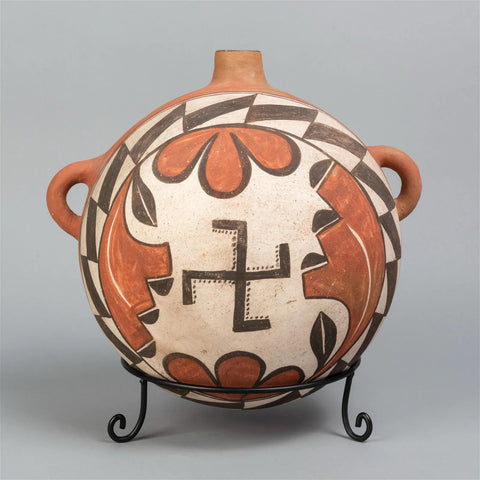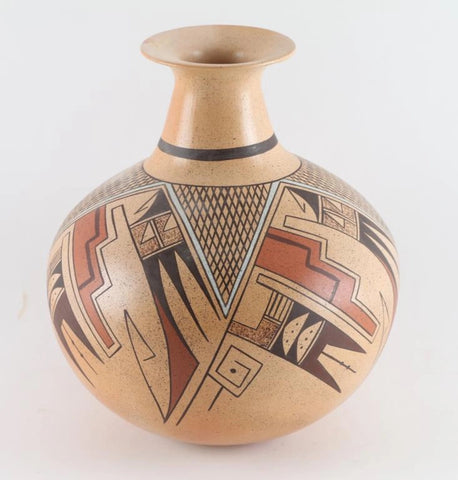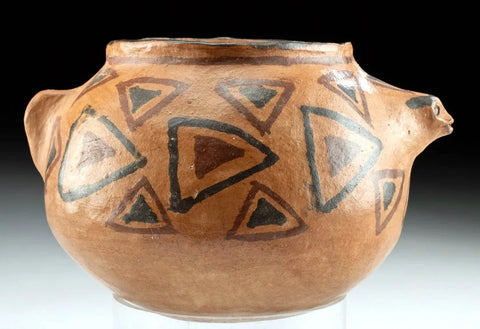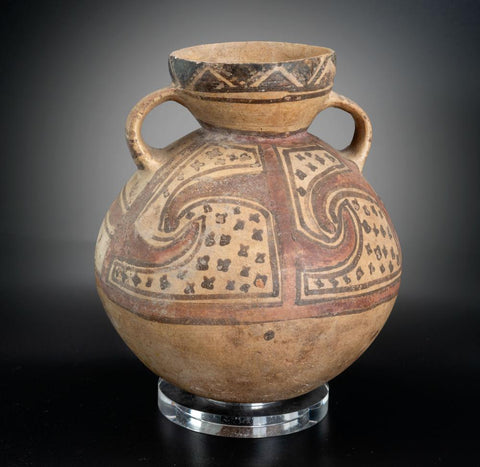
Native American, Vintage Hopi Tewa Poly Chrome Pottery Jar by Patty Maho, Ca 1970's, #1412
$ 994.00
Native American, Vintage Hopi Tewa Poly Chrome Pottery Jar by Patty Maho, Ca 1970's, #1412
Description: #1412 Native American, Vintage Hopi Tewa Poly Chrome Pottery Jar by Patty Maho, Ca 1970's, A nice example of design form and the random subtle effects of firing, traditional designs of scrolls, feathers and geometric s in brown and orange of buff ground, signed underside of the base.
Dimensions: Measures 4.5 x 6.5 inches.
Condition: Very good condition. There are no chips, cracks, repairs, scratches or areas of heavy wear.
Patty Maho was born about 1904 and lived for about 89 years, at Hano (Tewa Village),First Mesa, on the Hopi reservation in Arizona. Active as a potter from 1930-1979, she was known for her black and red on yellow bowls and red ware bowls. using parrot and feather designs. Examples of her work are in the collection of the Museum of Northern Arizona. She is cited in Hopi-Tewa Pottery by Gregory Schaff.
According to John Collins, Patty Maho did “not paint designs on her pottery; her sister, Mamie Nahoodyce, paint[ed] for her.” Mamie taught herself to paint pottery. For a great photograph of the two sisters, see Gaede (1977:18). Collins also reprints photographs of both Patty Maho and her sister (Collins, 1977:15). Patty Maho did not go to school, so she spoke only Tewa. Ms. Maho was Paqua Naha’s (see 2001-05) niece, cousin of Sadie Adams (see 1995-09 and 1996-02) and Lena Charlie (see 1998-04 and 2001-08), aunt of Beth Sakeva (see 1987-03) and great aunt of Neil David, Sr., and great-great aunt of Alfonso Sakeva, Jr. (see 1986-04). (Source: First People Pots)
“Pueblo pottery is made using a coiled technique that came into northern Arizona and New Mexico from the south, some 1500 years ago. In the four-corners region of the US, nineteen pueblos and villages have historically produced pottery. Although each of these pueblos use similar traditional methods of coiling, shaping, finishing and firing, the pottery from each is distinctive. Various clays gathered from each pueblo’s local sources produce pottery colors that range from buff to earthy yellows, oranges, and reds, as well as black. Fired pots are sometimes left plain and other times decorated—most frequently with paint and occasionally with appliqué. Painted designs vary from pueblo to pueblo, yet share an ancient iconography based on abstract representations of clouds, rain, feathers, birds, plants, animals and other natural world features.
Tempering materials and paints, also from natural sources, contribute further to the distinctiveness of each pueblo’s pottery. Some paints are derived from plants, others from minerals. Before firing, potters in some pueblos apply a light colored slip to their pottery, which creates a bright background for painted designs or simply a lighter color plain ware vessel. Designs are painted on before firing, traditionally with a brush fashioned from yucca fiber.
Different combinations of paint color, clay color, and slips are characteristic of different pueblos. Among them are black on cream, black on buff, black on red, dark brown and dark red on white (as found in Zuni pottery), matte red on red, and poly chrome—a number of natural colors on one vessel (most typically associated with Hopi). Pueblo potters also produce undecorated polished black ware, black on black ware, and carved red and carved black wares.
Making pueblo pottery is a time-consuming effort that includes gathering and preparing the clay, building and shaping the coiled pot, gathering plants to make the colored dyes, constructing yucca brushes, and, often, making a clay slip. While some Pueblo artists fire in kilns, most still fire in the traditional way in an outside fire pit, covering their vessels with large potsherds and dried sheep dung. Pottery is left to bake for many hours, producing a high-fired result.
Today, Pueblo potters continue to honor this centuries-old tradition of hand-coiled pottery production, yet value the need for contemporary artistic expression as well. They continue to improve their style, methods and designs, often combining traditional and contemporary techniques to create striking new works of art.” (Source: Museum of Northern Arizona)
Description: #1412 Native American, Vintage Hopi Tewa Poly Chrome Pottery Jar by Patty Maho, Ca 1970's, A nice example of design form and the random subtle effects of firing, traditional designs of scrolls, feathers and geometric s in brown and orange of buff ground, signed underside of the base.
Dimensions: Measures 4.5 x 6.5 inches.
Condition: Very good condition. There are no chips, cracks, repairs, scratches or areas of heavy wear.
Patty Maho was born about 1904 and lived for about 89 years, at Hano (Tewa Village),First Mesa, on the Hopi reservation in Arizona. Active as a potter from 1930-1979, she was known for her black and red on yellow bowls and red ware bowls. using parrot and feather designs. Examples of her work are in the collection of the Museum of Northern Arizona. She is cited in Hopi-Tewa Pottery by Gregory Schaff.
According to John Collins, Patty Maho did “not paint designs on her pottery; her sister, Mamie Nahoodyce, paint[ed] for her.” Mamie taught herself to paint pottery. For a great photograph of the two sisters, see Gaede (1977:18). Collins also reprints photographs of both Patty Maho and her sister (Collins, 1977:15). Patty Maho did not go to school, so she spoke only Tewa. Ms. Maho was Paqua Naha’s (see 2001-05) niece, cousin of Sadie Adams (see 1995-09 and 1996-02) and Lena Charlie (see 1998-04 and 2001-08), aunt of Beth Sakeva (see 1987-03) and great aunt of Neil David, Sr., and great-great aunt of Alfonso Sakeva, Jr. (see 1986-04). (Source: First People Pots)
“Pueblo pottery is made using a coiled technique that came into northern Arizona and New Mexico from the south, some 1500 years ago. In the four-corners region of the US, nineteen pueblos and villages have historically produced pottery. Although each of these pueblos use similar traditional methods of coiling, shaping, finishing and firing, the pottery from each is distinctive. Various clays gathered from each pueblo’s local sources produce pottery colors that range from buff to earthy yellows, oranges, and reds, as well as black. Fired pots are sometimes left plain and other times decorated—most frequently with paint and occasionally with appliqué. Painted designs vary from pueblo to pueblo, yet share an ancient iconography based on abstract representations of clouds, rain, feathers, birds, plants, animals and other natural world features.
Tempering materials and paints, also from natural sources, contribute further to the distinctiveness of each pueblo’s pottery. Some paints are derived from plants, others from minerals. Before firing, potters in some pueblos apply a light colored slip to their pottery, which creates a bright background for painted designs or simply a lighter color plain ware vessel. Designs are painted on before firing, traditionally with a brush fashioned from yucca fiber.
Different combinations of paint color, clay color, and slips are characteristic of different pueblos. Among them are black on cream, black on buff, black on red, dark brown and dark red on white (as found in Zuni pottery), matte red on red, and poly chrome—a number of natural colors on one vessel (most typically associated with Hopi). Pueblo potters also produce undecorated polished black ware, black on black ware, and carved red and carved black wares.
Making pueblo pottery is a time-consuming effort that includes gathering and preparing the clay, building and shaping the coiled pot, gathering plants to make the colored dyes, constructing yucca brushes, and, often, making a clay slip. While some Pueblo artists fire in kilns, most still fire in the traditional way in an outside fire pit, covering their vessels with large potsherds and dried sheep dung. Pottery is left to bake for many hours, producing a high-fired result.
Today, Pueblo potters continue to honor this centuries-old tradition of hand-coiled pottery production, yet value the need for contemporary artistic expression as well. They continue to improve their style, methods and designs, often combining traditional and contemporary techniques to create striking new works of art.” (Source: Museum of Northern Arizona)
Related Products
Sold out




